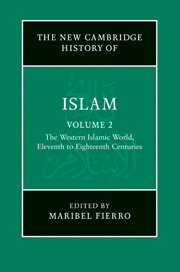Book contents
- Frontmatter
- Introduction
- PART I AL-ANDALUS AND NORTH AND WEST AFRICA (ELEVENTH TO FIFTEENTH CENTURIES)
- PART II EGYPT AND SYRIA (ELEVENTH CENTURY UNTIL THE OTTOMAN CONQUEST)
- PART III MUSLIM ANATOLIA AND THE OTTOMAN EMPIRE
- 10 The Turks in Anatolia before the Ottomans
- 11 The rise of the Ottomans
- 12 The Ottoman empire (tenth/sixteenth century)
- 13 The Ottoman empire: the age of ‘political households’ (eleventh–twelfth/seventeenth–eighteenth centuries)
- 14 Egypt and Syria under the Ottomans
- 15 Western Arabia and Yemen during the Ottoman period
- PART IV NORTH AND WEST AFRICA (SIXTEENTH TO EIGHTEENTH CENTURIES)
- PART V RULERS, SOLDIERS, PEASANTS, SCHOLARS AND TRADERS
- Glossary
- Bibliography
- Index
- References
15 - Western Arabia and Yemen during the Ottoman period
from PART III - MUSLIM ANATOLIA AND THE OTTOMAN EMPIRE
Published online by Cambridge University Press: 28 March 2011
- Frontmatter
- Introduction
- PART I AL-ANDALUS AND NORTH AND WEST AFRICA (ELEVENTH TO FIFTEENTH CENTURIES)
- PART II EGYPT AND SYRIA (ELEVENTH CENTURY UNTIL THE OTTOMAN CONQUEST)
- PART III MUSLIM ANATOLIA AND THE OTTOMAN EMPIRE
- 10 The Turks in Anatolia before the Ottomans
- 11 The rise of the Ottomans
- 12 The Ottoman empire (tenth/sixteenth century)
- 13 The Ottoman empire: the age of ‘political households’ (eleventh–twelfth/seventeenth–eighteenth centuries)
- 14 Egypt and Syria under the Ottomans
- 15 Western Arabia and Yemen during the Ottoman period
- PART IV NORTH AND WEST AFRICA (SIXTEENTH TO EIGHTEENTH CENTURIES)
- PART V RULERS, SOLDIERS, PEASANTS, SCHOLARS AND TRADERS
- Glossary
- Bibliography
- Index
- References
Summary
Introduction
Our knowledge of the political, social and intellectual history of the Ḥijāz and the Yemen during the ‘first’ Ottoman period (c. 923–1218/1517–1803) – that is during the reign of twenty-one sultans, from Selīm I (r. 918–26/1512–20) until the conquest of the Ḥijāz by the Wahhābīs in the reign of Selīm III (r. 1203–22/1789–1807) – remains fragmentary and has to be constituted mostly from primary sources such as local chronicles, biographical dictionaries, travellers’ accounts and the Ottoman and Arabian archives. The secondary literature, on the Ḥijāz in particular, consists of long and detailed lists of discrete events such as battles, floods and the internecine disputes between branches of the local ruling families as well as struggles with Ottoman administrative and military officials. A systematic and analytically informed history of the Sharīfs of Mecca and Medina in the Ottoman period has yet to be written and many lacunae persist. We know very little about the internal politics of the various branches of the family of Sharīfs, their relationships with the Yemeni imāms or the tribes of the Ḥijāz and Najd or even with their Ottoman overlords. We know even less about the social and intellectual history of the two Holy Cities and the tribal hinterland of the Ḥijāz. For instance, the fact that Shīʿī sentiment, and perhaps outright sectarian affiliation, remained predominant among many of the Ḥijāzī tribes (e.g. Ḥarb, Juhayna) until the arrival of the Wahhābīs in the late twelfth/eighteenth century is virtually unknown.
- Type
- Chapter
- Information
- The New Cambridge History of Islam , pp. 436 - 450Publisher: Cambridge University PressPrint publication year: 2010



